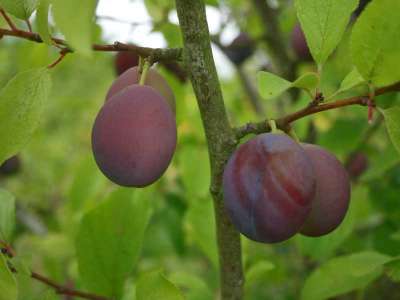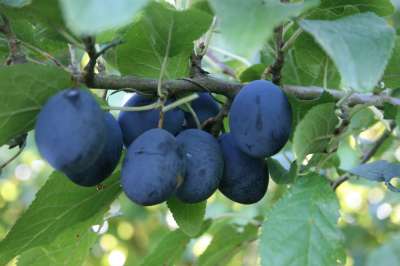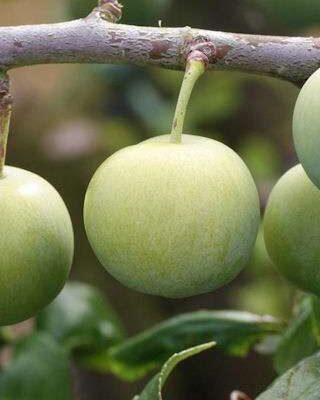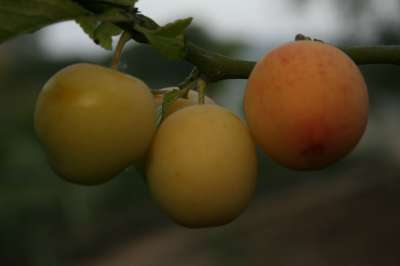Your basket is currently empty!
Perhaps the most delectable of all the fruits, can you ever have too many Plums? Gages and Damsons are closely inter-related; the former generally require a warmer aspect than Plums, whilst the latter are hardier still and do well in Northern areas. All appreciate the same general cultivation rules and are grafted on to the same rootstocks.
Buy Plum trees for immediate planting by clicking here.

Rootstocks for Plum, Gage & Damson trees
There is only a limited selection of rootstocks for plum trees, listed in order of size, smallest first.
Pixy
Pixy is by far the most popular tree and the most satisfactory for garden use. It is moderately dwarfing to semi vigorous and fairly adaptable in it’s size. It can be kept to just 190-200cm’s in height, or allowed to grow a bit more than that. Space 180cm’s apart. Suitable for growing in 20-24” containers, or as an intensive orchard or smaller grassy area. Heavy crops can be achieved. Pixy is ideal for small bush trees or cordon, column and stepover training. Generally more precocious than St Julien.
St Julien A
St Julien A is a much more vigorous tree and ideal for a traditional orchard setting or the larger garden or paddock etc. Once established it’s yields will be greater than Pixy. St Julien A will mature into a tree of 360cm’s or more in height and perhaps a little less in width. It is used for larger bush tree, half standard and fan trained applications.
Brompton & Myrobalam
Brompton & Myrobalam stocks super-vigorous, hardy trees suitable for poorer soil and very large area’s. Seldom recommended these days as the fruit is very difficult to pick as it is largely out of reach without a tall ladder.
Good varieties of Plum
Looking for failsafe, extra juicy and flavoursome Plums – then select from this list of recommended varieties.
Opal
The first and most predominant early variety, Opal has red-purple fruits which are quite small but sweet and suitable for dessert use. A good growing tree, ripening late July.
Czar
Czar [also known as ‘The Czar’] is such a hardy growing tree it is suitable for all areas and is self fertile too, as well as being a good pollinator for other varieties. Czar has deep purple fruits that are quite early, and may be used from late July. Mainly used for all culinary purposes, at which it excels, but does suit dessert use also. One of the classic varieties.
Rivers Early Prolific
Dual purpose with oval dark blue purple fruits with green-yellow flesh. A hardy good-doer, early season and justifiably popular.
Violetta
A new variety from Sweden that is already performing really well. This naturally compact and self fertile tree is super-hardy and prolific with a juicy golden flesh just ideal for eating flesh. Already highly regarded.
Pershore Yellow Egg
If you are looking for a really sweet cooking Plum then Pershore Yellow Egg is the answer. This variety tends to do well no matter what and often survives today in old neglected orchards. The fruits cook to a very juicy deep yellow that needs little sugar. Jams made from this variety are wonderful!
Jubilee
The newest variety on the block is also already the most hardy. Known for it’s ultra hardy durability, this very, very reliable variety bears fruits of a good quality that suit dessert first and foremost. Ripening 10 days before Victoria but exceeds that variety considerably in weight and quality of crop. The number one choice for garden growing. Self fertile.
Manns no 1
A relatively obscure variety, but worth mentioning as a form of Victoria that is more disease resistant and has the same sumptuous flavour. Pictured below.
Marjories Seedling
Marjories is a late season extender that we always like to suggest. Its fruits are quite large and hang on the tree well into October giving valuable late fruits. They are a splendid dusky purple and have a juicy green-yellow interior that suits all purposes. Self pollinating.
Burbanks Giant Prune
Known under many seudonyms but none disguise the cast-iron constitution of this frost hardy variety. The fruits are very oval, a striking deep red and firmly textured, suitable for all cooking purposes. Great for the north., self fertile.
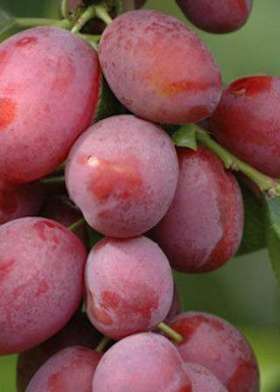
Good varieties of Greengage
Recommendations for Gage trees include Oullins Golden Gage, Cambridge Gage, Dennistons Superb and Stella’s Star.
Recommendations for Damson varieties
Merryweather and Shropshire Damson remain the classics to which all others are compared.
Bugs and diseases of Plum, Gage & Damson
Aphids/Greenfly
Aphids/Greenfly are the most common problems of Plum Gage and Damson trees and appear under several guises –leaf curling and mealy aphid, greenfly, whitefly and woolly aphid can all settle and make colonies. Biological controls are available or you can spray light infestations on small trees with soapy water which will often rid them. But heavier or larger infestations really need treating with a systemic insecticide such as Provado. Woolly aphid inm particular seems difficult to eradicate without a systemic insecticide.
Canker
Canker appears most commonly on the main trunks and branches as sap or sticky gum oozes from the bark.
The disease is more troublesome in the wetter area’s of the country. The best course of action is to cut out infected wood, beyond the point of infection leaving only clean growth. If the canker is on the main trunk or a major limb then spraying with bordeaux mixture can help. Some varieties are more susceptable to canker than others. Sticky sap can also be produced if the tree is stressed so don’t automatically assume it is canker.
Silverleaf
Silverleaf is a name guaranteed to strike fear into the heart of any would-be fruit grower but be aware that bad infestations of powdery mildew look similar. True Silverleaf is quite uncommon and after the silvering of individual branches, die back occurs. Cut pieces of wood show a dark brown stain.The only remedy is swift removal of affected branches, down to healthy wood and the wounds should then be sealed with a tree wound paint. The pruning saw should be kept srupulously clean as you work. Silverleaf can affect other trees as well but is most common on Plum.
Plum moth
Plum moth is the culprit when you cut into a seemingly perfect Plum only to find it damaged inside and liberally sprinkled with fine grains of maggot faeces! This troublesom pest can be controlled by pheromone traps hung around the trees from June to August. A systemic insecticide may also be helpful applied to the young developing fruits or straight after blossom set.



